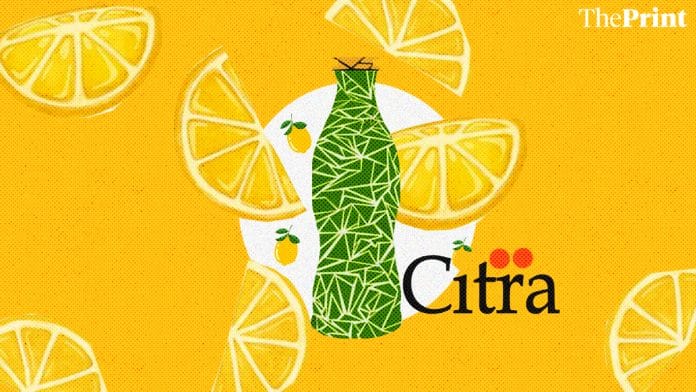Across India, lemon drinks or nimbu paani has been the quintessential refresher served in homes. Small wonder then that in 1985-86, Parle’s Ramesh Chauhan launched a clear lemon drink — Citra. He is the same man who had launched Gold Spot, Limca, Thums Up, and Maaza when the Janata Party government forced MNCs like Coca-Cola out of India in 1977.
“Although there was already Limca, there was no clear lemon drink and I realised there was ample scope in the market…so, I decided to introduce Citra,” Chauhan told ThePrint.
Citra, or Chitra as it was popularly called by many, managed to create its own niche market in Kerala and in many parts of north India. In fact, most Parle’s drinks had a monopoly on the soft drink market.
Also read: Bollywood star on ads, Disneyland tickets, space-age branding & yet Thril cola fizzled out
Brand guru Harish Bijoor pointed out that drinks made from the humble lime juice have always remained a favourite with Indians.
“The simple lime juice made at homes evolved and reached the street corners, where the same would be served with soda and then came the carbonated lime drinks available at shop,” Bijoor said. “We had Limca, which was a cloudy, lemony drink and then there was Citra, with a slightly different flavour and look.”
Citra clearly targeted the young with its television and print ads.
Positioned as a super cooler, Citra gave the much-required break from the monotony of Limca.
Its catchy television ad jingle brought out this unique selling proposition by driving home the point that it was a cool and refreshing drink. The ad shows a huge hall full of tired and bored people reeling under the heat until a young woman walks in and opens a green-coloured bottle of Citra.
Also read: ‘Livva little hot’ Rekha, a cola war and the zing thing: Remembering Gold Spot
Santosh Sood, a marketing and advertising specialist, explained that the launch of lemon drinks in India, including Citra, was aimed at taking a humble drink to the level of indulgence. “Nimbu paani has been embedded in our culture and therefore was perceived to be better than the ‘firangi’ colas,” he said. “In a way these lime drinks gave the feeling of doing-good with feeling-good,” he added. “Colas were restricted to just feel-good.”
Most carbonated drinks have their own defined set of fiercely loyal customers.”Citra was no different, it had it’s own loyal customers as well. It was clear that if you are a Citra drinker you will not drink any other lemony drink,” noted a marketing analyst in the beverage sector.
In 1993, Coca-Cola was back in India and bought out many of the soft drinks brands of Parle, including Citra.
“It bought out most of the aerated water brands of Parle Bisleri — its primary competition and decided to put them to sleep as it had to launch its own brands,” the analyst said.
Coca-Cola’s brand Sprite took the place of Citra.
Also read: Campa Cola was India’s answer to Coca-Cola and was the perfect fit
While Coca-Cola has relaunched a few dead brands that it bought from Parle Bisleri, Citra is unlikely to get a second life.
“Sprite, which is Coca-Cola’s signature brand, is doing extremely well in the Indian markets…there is absolutely no need to relaunch Citra,” said an analyst.
While there have been reports that Coca-Cola would relaunch Citra, company insiders said there was no such plan.
“The sad thing is that these strong brands failed to become even bigger because they had been off the shelf for years,” he said.






